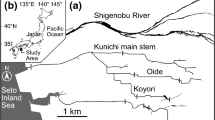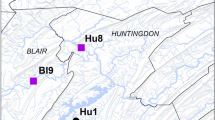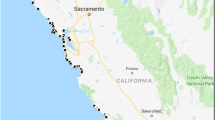Abstract
On-ground management actions targeting invasive and/or native species are often undertaken based on incomplete and biased distribution data for the species of interest. Once an invasive species becomes established, containment can provide an effective management option to conserve native biodiversity only if it is implemented beyond the outer distribution limits of the species of interest. Determining these outer distribution limits is currently difficult for freshwater fish species because of the low sensitivity and biases associated with conventional monitoring methods. The improved sensitivity of environmental DNA-based surveys makes them particularly useful to determine these outer distribution limits. In this study, we used conventional monitoring methods and eDNA-based monitoring using real-time PCR to determine the spread of the invasive redfin perch (Perca fluviatilis) in an intermittent river system. This voracious predatory fish is responsible for the continued decline of several threatened and vulnerable species within Australia. We found that eDNA detection rates were high in our study system, when redfin perch presence was confirmed by conventional monitoring, compared to previously published works. Additionally we describe how the combination of conventional and eDNA-based monitoring can improve redfin perch distribution data compared to conventional monitoring alone. This improvement has subsequently been used to inform management and determine the optimal location for the construction of an exclusion barrier.

Similar content being viewed by others
References
Barnes MA, Turner CR, Jerde CL et al (2014) Environmental conditions influence eDNA persistence in aquatic systems. Environ Sci Technol 48:1819–1827
Britton JR, Gozlan RE, Copp GH (2011a) Managing non-native fish in the environment. Fish Fish 12:256–274
Britton JR, Pegg J, Gozlan RE (2011b) Quantifying imperfect detection in an invasive pest fish and the implications for conservation management. Biol Conserv 144:2177–2181
Caffrey JM, Baars J, Barbour JH et al (2014) Tackling Invasive Alien Species in Europe: the top 20 issues. Manag Biol Invasions 5:1–20
Campbell SP, Clark JA, Crampton LH et al (2009) An assessment of monitoring efforts in endangered species recovery plans. Ecol Appl 12:674–681
Doi H, Uchii K, Takahara T et al (2015) Use of droplet digital PCR for estimation of fish abundance and biomass in environmental DNA surveys. PLoS ONE 10:e0122763
Dowle E, Pochon X, Banks J et al (2015) Targeted gene enrichment and high throughput sequencing for environmental biomonitoring: a case study using freshwater macroinvertebrates. Mol Ecol Resour. doi:10.1111/1755-0998.12488
Fischer JR, Quist MC (2014) Characterizing lentic freshwater fish assemblages using multiple sampling methods. Environ Monit Assess 186:4461–4474
Furlan E, Gleeson D (2016a) Improving reliability in environmental DNA detection surveys through enhanced quality control. Mar Freshw Res. doi:10.1071/MF1534
Furlan EM, Gleeson D (2016b) Environmental DNA detection of redfin perch, Perca fluviatilis. Conserv Genet Resour. doi:10.1007/s12686-016-0523-1
Furlan EM, Gleeson D, Hardy CM, Duncan RP (2016) A framework for estimating the sensitivity of eDNA surveys. Mol Ecol Resour 16:641–654
Geist J (2011) Integrative freshwater ecology and biodiversity conservation. Ecol Indic 11:1507–1516
Gilligan D, McGarry T, Carter S (2010) A scientific approach to develo** habitat rehabilitation strategies in aquatic environments: a case study on the endangered Macquarie perch (Macquaria australasica) in the Lachlan catchment. http://www.dpi.nsw.gov.au/content/research/areas/aquatic-ecosystems/outputs/2010/1747
Goldberg CS, Strickler KM, Pilliod DS (2014) Moving environmental DNA methods from concept to practice for monitoring aquatic macroorganisms. Biol Conserv 183:1–3
Gormley AM, Forsyth DM, Griffioen P et al (2011) Using presence-only and presence-absence data to estimate the current and potential distributions of established invasive species. J Appl Ecol 48:25–34
Gozlan RE, Britton JR, Cowx I, Copp GH (2010) Current knowledge on non-native freshwater fish introductions. J Fish Biol 76:751–786
Herder J, Valentini A, Kranenbarg J (2012) Detectie van grote modderkruipers met behulp van environmental DNA. H2O 3:25–27
Hulme PE (2009) Trade, transport and trouble: managing invasive species pathways in an era of globalization. J Appl Ecol 46:10–18
Jane SF, Wilcox TM, McKelvey KS et al (2014) Distance, flow, and PCR inhibition: eDNA dynamics in two headwater streams. Mol Ecol Resour 15:216–227
Jerde CL, Mahon AR, Chadderton WL, Lodge DM (2011) “Sight-unseen” detection of rare aquatic species using environmental DNA. Conserv Lett 4:150–157
Jerde DL, Cadderton WL, Mahon AR et al (2013) Detection of Asian carp DNA as part of a basin-wide Great Lakes surveillance program. Can J Fish Aquat Sci 70:522–526
Klymus KE, Richter CA, Chapman DC, Paukert C (2014) Quantification of eDNA shedding rates from invasive bighead carp Hypophthalmichthys nobilis and silver carp Hypophthalmichthys molitrix. Biol Conserv 183:77–84
Koehn JD, MacKenzie RF (2004) Priority management actions for alien freshwater fish species in Australia. N Z J Mar Freshw Res 38:457–472
Lahoz-Monfort JJ, Guillera-Arroita G, Tingley R (2016) Statistical approaches to account for false positive errors in environmental DNA samples. Mol Ecol Resour 16:673–685
Laramie MB, Pilliod DS, Goldberg CS (2014) Characterizing the distribution of an endangered salmonid using environmental DNA analysis. Biol Conserv 183:29–37
Lintermans M (2007) Fishes of the Murray–Darling Basin: An introductory guide. Murray-Darling Basin Authority, Canberra
Lintermans M (2013a) Recovering threatened freshwater fish in Australia. Mar Freshw Res 64:3–6
Lintermans M (2013b) A review of on-ground recovery actions for threatened freshwater fish in Australia. Mar Freshw Res 64:775–791
Lintermans M (2015) Finding the needle in the haystack: comparing sampling methods for detecting an endangered freshwater fish. Mar Freshw Res. doi:10.1071/MF14346
Maruyama A, Nakamura K, Yamanaka H et al (2014) The Release Rate of Environmental DNA from Juvenile and Adult Fish. PLoS ONE 9:e114639
Maxwell D, Jennings S (2005) Power of monitoring programmes to detect decline and recovery of rare and vulnerable fish. J Appl Ecol 42:25–37
McKee AM, Spear SF, Pierson TW (2014) The effect of dilution and the use of a post-extraction nucleic acid purification column on the accuracy, precision, and inhibition of environmental DNA samples. Biol Conserv 183:70–76
Minamoto T, Naka T, Moji K, Maruyama A (2016) Techniques for the practical collection of environmental DNA: filter selection, preservation, and extraction. Limnology 17:23–32
Neebling TE, Quist MC (2011) Comparison of boat electrofishing, trawling, and seining for sampling fish assemblages in Iowa’s nonwadeable rivers. North Am J Fish Manag 31:390–402
Olden JD, Kennard MJ, Pusey BJ (2007) Species invasions and the changing biogeography of Australian freshwater fishes. Glob Ecol Biogeogr 17:25–37
Pearce L (2015) Surveys, monitoring and conservation status of Southern Pygmy Perch (Nannoperca australis) within Blakney and Pudman Creeks. http://www.dpi.nsw.gov.au/__data/assets/pdf_file/0011/551927/southern_pygmy_perch_web_version.pdf
Pilliod DS, Goldberg CS, Arkle RS, Waits LP (2014) Factors influencing detection of eDNA from a stream-dwelling amphibian. Mol Ecol Resour 14:109–116
Porreca AP, Pederson CL, Laursen JR, Colombo RE (2013) A comparison of electrofishing methods and fyke netting to produce reliable abundance and size metrics. J Freshw Ecol 28:585–590
Rees HC, Bishop K, Middleditch DJ et al (2014a) The application of eDNA for monitoring of the Great Crested Newt in the UK. Ecol Evol 4:4023–4032
Rees HC, Maddison BC, Middleditch DJ et al (2014b) The detection of aquatic animal species using environmental DNA—a review of eDNA as a survey tool in ecology. J Appl Ecol 51:1450–1459
Renshaw MA, Olds BP, Jerde CL et al (2014) The room temperature preservation of filtered environmental DNA samples and assimilation into a Phenol–Chloroform–Isoamyl alcohol DNA extraction. Mol Ecol Resour 15:168–176
Roussel J-M, Paillisson J-M, Tréguier A, Petit E (2015) The downside of eDNA as a survey tool in water bodies. J Appl Ecol 52:823–826
Sarre SD, Macdonald AJ, Berry OF et al (2014) Defining specificity in DNA detection of wildlife: response to Gonçalves et al. “the risks of using” species-specific “PCR assays in wildlife research: the case of red fox (Vulpes vulpes) identification in Tasmania”. Forensic Sci Int Genet 13:206–207
Sigsgaard EE, Carl H, Møller PR, Thomsen PF (2015) Monitoring the near-extinct European weather loach in Denmark based on environmental DNA from water samples. Biol Conserv 183:46–52
Strickler KM, Fremier AK, Goldberg CS (2014) Quantifying effects of UV-B, temperature, and pH on eDNA degradation in aquatic microcosms. Biol Conserv 183:85–92
Takahara T, Minamoto T, Yamanaka H et al (2012) Estimation of fish biomass using environmental DNA. PLoS ONE 7:e35868
Thomsen PF, Kielgast J, Iversen LL et al (2012) Monitoring endangered freshwater biodiversity using environmental DNA. Mol Ecol 21:2565–2573
Turner CR, Barnes MA, Xu CCY et al (2014a) Particle size distribution and optimal capture of aqueous macrobial eDNA. Methods Ecol Evol 5:676–684
Turner CR, Uy KL, Everhart RC (2014b) Fish environmental DNA is more concentrated in aquatic sediments than surface water. Biol Conserv 183:93–102
Valentini A, Pompanon F, Taberlet P (2009) DNA barcoding for ecologists. Trends Ecol Evol 24:110–117
Valentini A, Taberlet P, Miaud C et al (2016) Next-generation monitoring of aquatic biodiversity using environmental DNA metabarcoding. Mol Ecol 25:929–942
Vilizzi L, Copp GH (2013) Application of FISK, an invasiveness screening tool for non-native freshwater fishes, in the Murray–Darling Basin (Southeastern Australia). Risk Anal 33:1432–1440
Wilson CC, Wozney KM, Smith CM (2016) Recognizing false positives: synthetic oligonucleotide controls for environmental DNA surveillance. Methods Ecol Evol 7:23–29
Acknowledgments
Funding for this project was provided by New South Wales Department of Primary Industries and the Invasive Animal Cooperative Research Centre (Project 1.W.2). We would like to acknowledge the contribution of three anonymous reviewers whose comments have greatly improved the manuscript. Traditional monitoring was conducted under the approval of the NSW DPI Animal Care and Ethics Committee (Permit Number: 05/06).
Author information
Authors and Affiliations
Corresponding author
Electronic supplementary material
Below is the link to the electronic supplementary material.
Rights and permissions
About this article
Cite this article
Bylemans, J., Furlan, E.M., Pearce, L. et al. Improving the containment of a freshwater invader using environmental DNA (eDNA) based monitoring. Biol Invasions 18, 3081–3089 (2016). https://doi.org/10.1007/s10530-016-1203-5
Received:
Accepted:
Published:
Issue Date:
DOI: https://doi.org/10.1007/s10530-016-1203-5




